Saigon Attractions - Ho Chi Minh Sightseeing and things
to see
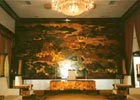 The Reunification Palace is beautiful in its ugliness, a 1960s monstrosity
designed with the help of Soviet architects. Most people will remember
the image of a North Vietnamese tank crashing through the gates on 30
April 1975 signifying the fall of Saigon. The tank still graces the front
lawn. Rooms open to the public remain exactly as they were in 1975, showing
where important meetings were held during the war, as well as some of
the private quarters of the president and his family. Most fascinating
are a series of underground tunnels housing a telecommunications centre.
The Reunification Palace is beautiful in its ugliness, a 1960s monstrosity
designed with the help of Soviet architects. Most people will remember
the image of a North Vietnamese tank crashing through the gates on 30
April 1975 signifying the fall of Saigon. The tank still graces the front
lawn. Rooms open to the public remain exactly as they were in 1975, showing
where important meetings were held during the war, as well as some of
the private quarters of the president and his family. Most fascinating
are a series of underground tunnels housing a telecommunications centre.
Nam Ky Khoi Ngia, District 1
Tel: (08) 822 3652.
Opening hours: Daily 0730-1100 and 1300-1600.
Admission: VND20,000 (including brochure).
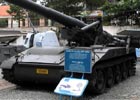 Formerly known as the Museum of American War Crimes, the name has been
toned down so as not to offend its US visitors and is now the War Remnants
Museum. This is not a museum for the sensitive as it houses instruments
of torture and hundreds of photographs of atrocities committed during
the 20th century and, in particular, the Vietnam War. Visitors cannot
fail to be moved as the exhibits provide a context for a period of history
many only know from old newsreels and Hollywood movies. At the front of
the museum is a small collection of military hardware and, most interestingly,
the mobile guillotine used by the French colonists to dispense justice
throughout the country before World War II.
Formerly known as the Museum of American War Crimes, the name has been
toned down so as not to offend its US visitors and is now the War Remnants
Museum. This is not a museum for the sensitive as it houses instruments
of torture and hundreds of photographs of atrocities committed during
the 20th century and, in particular, the Vietnam War. Visitors cannot
fail to be moved as the exhibits provide a context for a period of history
many only know from old newsreels and Hollywood movies. At the front of
the museum is a small collection of military hardware and, most interestingly,
the mobile guillotine used by the French colonists to dispense justice
throughout the country before World War II.
28 Vo Van Tan, District 3
Tel: (08) 930 5587.
Opening hours: Daily 0730-1145 and 1330-1715.
Admission: VND10,000.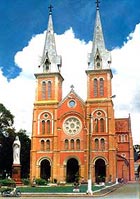
The twin towers of Notre Dame Cathedral have been a familiar landmark
in Ho Chi Minh City since the 1880s. In front of the cathedral in a small
garden is a delicate statue of the Virgin Mary. The interior of the cathedral
is rather plain, unlike most French cathedrals, with no stained glass
but it is a cool escape from the heat outside.
Dong Khoi, District 1
Opening hours: No formal times.
Admission: Free; donations appreciated.
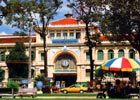 Across from the Notre Dame Cathedral, the vast Post Office was also built
in the late 19th century in European style. The interior has hardly been
touched since it was built and is dominated by a huge portrait of Ho Chi
Minh. The building always seems busy but most people are just visitors
rather than customers.
Across from the Notre Dame Cathedral, the vast Post Office was also built
in the late 19th century in European style. The interior has hardly been
touched since it was built and is dominated by a huge portrait of Ho Chi
Minh. The building always seems busy but most people are just visitors
rather than customers.
2 Cong Xa Paris, District 1
Tel: (08) 829 9615.
Opening hours: Daily 0630-2130.
Admission: Free.
 Housed in the former building of the Government of Cochinchina, the Ho
Chi Minh City Museum (formerly the Revolutionary Museum) contains artefacts,
such as weapons, uniforms, medals and old photos, from the period of Communist
struggle against the French and the Americans. Unfortunately, the exhibits
are only labelled in Vietnamese but some are self-explanatory. Outside
the museum is a collection of military hardware including a tank and a
helicopter.
Housed in the former building of the Government of Cochinchina, the Ho
Chi Minh City Museum (formerly the Revolutionary Museum) contains artefacts,
such as weapons, uniforms, medals and old photos, from the period of Communist
struggle against the French and the Americans. Unfortunately, the exhibits
are only labelled in Vietnamese but some are self-explanatory. Outside
the museum is a collection of military hardware including a tank and a
helicopter.
65 Ly Tu Trong, District 1
Tel: (08) 829 9743 or 829 9741.
Opening hours: Daily 0800-1600.
Admission: VND10,000.
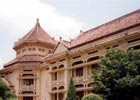 Located just inside the entrance to the Botanical Gardens and Zoo, the
Historical Museum houses a collection of artefacts covering the last 2000
years of Vietnamese history including items belonging to ancient cultures
such as Dong Son, Oc Eo and Cham. The museum was built in 1929 and the
collection assembled by the Ecole Francaise d’Extreme Orient.
Located just inside the entrance to the Botanical Gardens and Zoo, the
Historical Museum houses a collection of artefacts covering the last 2000
years of Vietnamese history including items belonging to ancient cultures
such as Dong Son, Oc Eo and Cham. The museum was built in 1929 and the
collection assembled by the Ecole Francaise d’Extreme Orient.
Nguyen Binh Khiem, District 1
Tel: (08) 829 8146.
Opening hours: Daily 0800-1120 and 1330-1620.
Admission: VND10,000.
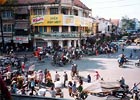 Cholon is in District 5 and is a maze of narrow streets, bustling with
people. Most of Vietnam’s ethnic Chinese live here and they are the
largest single ethnic minority group in the country. Merchants began to
settle in Cholon in the 1770s, although many ethnic Chinese fled the country
in 1975.
Cholon is in District 5 and is a maze of narrow streets, bustling with
people. Most of Vietnam’s ethnic Chinese live here and they are the
largest single ethnic minority group in the country. Merchants began to
settle in Cholon in the 1770s, although many ethnic Chinese fled the country
in 1975.
The Thien Hau Pagoda is one of Cholon’s must-sees. It is dedicated
to the goddess Thien Hau, protector of the sea. Photographers are spoilt
for choice with the ornate decoration inside the pagoda and the statues
of Thien Hau. It is popular with worshippers (the air is always heavy
with the smell of incense) and there are regular festivals during the
lunar calendar.
Binh Tay Market throngs with people from early morning and the gloomy,
narrow walkways are crammed with consumer items and exotic foodstuffs.
The sound of bargaining, quite often in Chinese rather than Vietnamese,
and the calls of the vendors constantly fill the air. This is one of the
best places to see the locals going about their daily lives.
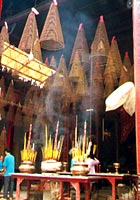
The Jade Emperor Pagoda is one of the most attractive pagodas in the city.
Dedicated to various Chinese-Vietnamese divinities, in a mixture of Taoist
and Buddhist styles, the pagoda houses numerous statues and delicate woodcarvings
with intricate tiles on the roof.
Mai Thi Luu, District 3
Opening hours: No formal times.
Admission: Free; donations appreciated.
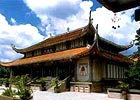 Located three kilometres (two miles) from Cholon, the Giac Lam Pagoda
is believed to be the oldest pagoda in the city and is a calm place to
visit. Families of the old and sick regularly go to the pagoda to pin
supplications to the large bronze bell, in the belief that when it is
rung the messages will be sent to the heavens above.
Located three kilometres (two miles) from Cholon, the Giac Lam Pagoda
is believed to be the oldest pagoda in the city and is a calm place to
visit. Families of the old and sick regularly go to the pagoda to pin
supplications to the large bronze bell, in the belief that when it is
rung the messages will be sent to the heavens above.
Lac Long Quan, District 11
Opening hours: No formal times.
Admission: Free; donations appreciated.
 The Botanical Gardens were established by the French in 1864 and once
had the reputation of being some of the finest in Asia. Now, however,
the area is just a pleasant one for a stroll in the heart of the city,
among tropical plants and trees. The Zoo is not up to Western standards,
with poor enclosures.
The Botanical Gardens were established by the French in 1864 and once
had the reputation of being some of the finest in Asia. Now, however,
the area is just a pleasant one for a stroll in the heart of the city,
among tropical plants and trees. The Zoo is not up to Western standards,
with poor enclosures.
Nguyen Binh Khiem, District 1
Tel: (08) 829 3728.
Opening hours: Daily 0700-2000.
Admission: VND8000.
|

